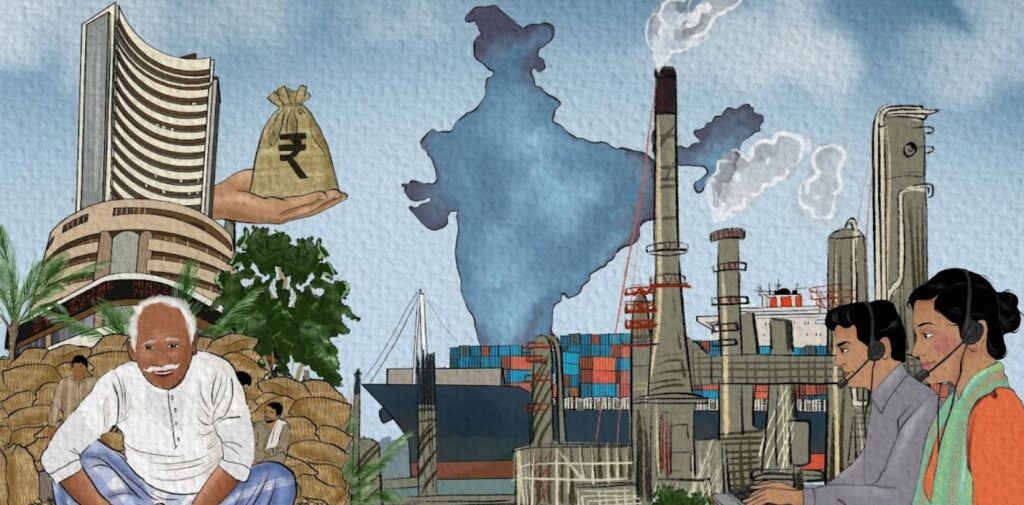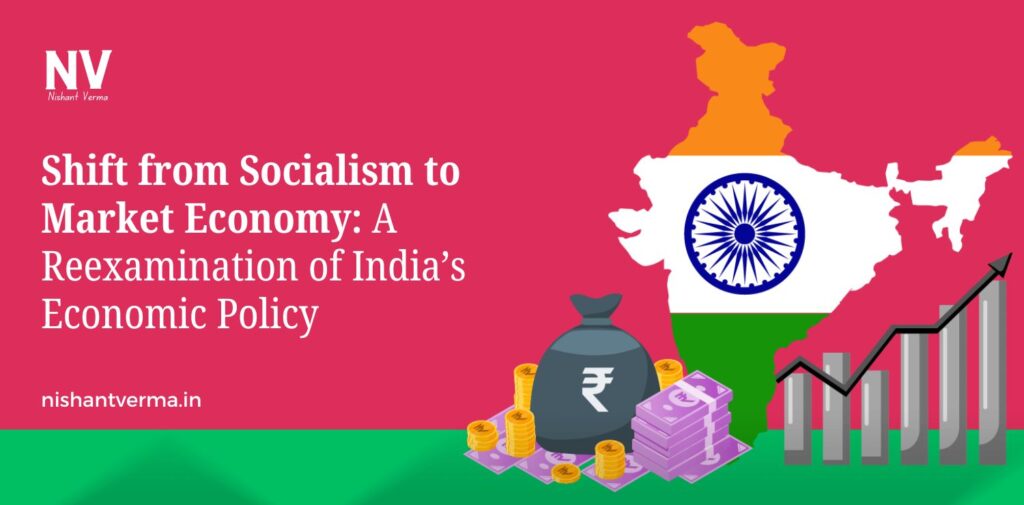India’s economic transformation over the past few decades has been nothing short of extraordinary. The shift from a socialist-oriented economy to a market-driven economy since the early 1990s has redefined the country’s economic landscape. This transformation, often referred to as India’s economic liberalization, marked a turning point in the nation’s development trajectory. In this article, we will explore the historical context of India economic policiy, the transition to a market economy, and the challenges and achievements of this shift.
The Socialist Economy: Foundations and Challenges
After gaining independence in 1947, India adopted a socialist model of economic planning, heavily influenced by the Soviet Union. The government took on a dominant role in the economy, focusing on state ownership of key industries, central planning, and economic self-reliance. This model was intended to promote equality, reduce poverty, and build a strong industrial base. The approach was rooted in the belief that the state should control the commanding heights of the economy, such as steel, coal, and telecommunications, to foster development and national security.
The Five-Year Plans, introduced in 1951, were a central feature of this socialist framework. These plans were designed to outline the country’s economic priorities, including industrial growth, infrastructure development, and poverty alleviation. However, despite these ambitious goals, the socialist economy faced numerous challenges. A growing population, inefficiencies in state-owned enterprises, bureaucratic red tape, and a lack of competition led to slow economic growth. By the 1980s, it became clear that the socialist model was failing to address the country’s needs for modernization, job creation, and overall economic growth.

The Crisis of the 1990s: A Turning Point for India
The major turning point in India economic policy came in the early 1990s. The country faced an acute economic crisis, marked by a balance of payments crisis and dwindling foreign exchange reserves. India was on the verge of defaulting on its debt obligations. The crisis was a result of various factors, including inefficiency in state-run industries, a large fiscal deficit, and a rigid import substitution policy that had hampered the country’s competitiveness.
In response to the crisis, India turned to the International Monetary Fund (IMF) for assistance. The government, led by then-Prime Minister P.V. Narasimha Rao and Finance Minister Manmohan Singh, introduced a series of bold economic reforms in 1991. These reforms aimed to break the constraints of the socialist model and open up the economy to market forces. The shift towards a market economy was driven by the need for greater economic growth, foreign investment, and modernization.
Key Reforms in India’s Shift to a Market Economy
The economic liberalization of the 1990s was characterized by several key reforms that helped reshape India’s economic policies and infrastructure. The major changes introduced included:
- Deregulation: The government reduced the control it had over industries and markets. This included the relaxation of industrial licensing and the removal of restrictions on private businesses. The move aimed to encourage entrepreneurship and competition, which were seen as key drivers of economic growth.
- Trade Liberalization: India reduced tariffs and removed import restrictions, opening its markets to foreign goods and services. This shift towards free trade was intended to expose Indian industries to global competition and attract foreign investments.
- Privatization of State-Owned Enterprises: The government began the process of selling off its stakes in many state-owned enterprises. This was intended to improve efficiency and raise capital that could be used for development purposes.
- Financial Sector Reforms: The Indian financial system was overhauled to align more closely with global standards. The reforms included the liberalization of the banking sector, greater autonomy for the Reserve Bank of India (RBI), and the introduction of modern financial instruments and markets.
- Foreign Direct Investment (FDI) Policies: India opened up key sectors such as telecommunications, retail, and aviation to foreign investment. The idea was to attract capital and expertise to bolster the country’s economic development.
These reforms, though initially controversial, laid the foundation for India’s economic growth in the decades that followed. The shift to a market economy marked the end of the state’s monopoly in many sectors and ushered in a new era of private enterprise, foreign investment, and global trade.

Impact of the Shift: Economic Growth and Development
The results of India’s economic liberalization have been profound. The shift from a socialist model to a market economy unleashed a wave of growth and development. Since the 1990s, India has consistently posted high GDP growth rates, averaging around 6-8% annually. This sustained economic growth has helped lift millions of people out of poverty and transform India into one of the world’s largest economies.
One of the most significant achievements of this transformation has been the expansion of the services sector. The liberalization policies allowed industries such as information technology (IT), business process outsourcing (BPO), and telecommunications to thrive. India became a global leader in IT services, with companies like Infosys, Tata Consultancy Services (TCS), and Wipro expanding their reach worldwide. The growth of the services sector also created millions of jobs, particularly in urban areas.
Another notable achievement has been the rise of the middle class. As the economy grew, more people gained access to education, healthcare, and consumer goods, resulting in a larger and more prosperous middle class. This demographic shift has driven domestic consumption and contributed to India’s growing importance in global markets.
In addition to economic growth, India’s market reforms helped improve global competitiveness. The liberalization of trade, the easing of regulatory burdens, and the focus on innovation and entrepreneurship helped Indian companies compete on the global stage. India also attracted foreign investment, becoming an attractive destination for multinational corporations looking to tap into its large consumer base and growing economy.
Challenges in the Transition to a Market Economy
While the shift to a market economy has brought numerous benefits, it has not been without challenges. One of the major issues India has faced is the inequality created by economic growth. While many have benefited from the liberalization, the gains have not been equally distributed. The divide between the rich and poor has widened, and many rural areas still struggle with poverty, lack of infrastructure, and limited access to education and healthcare.
Another challenge is the informal economy. Despite India’s growing formal economy, a significant portion of the workforce remains in the informal sector, working in unregulated jobs with low wages and poor working conditions. This has led to concerns about job security, workers’ rights, and labor exploitation.
Additionally, the agriculture sector has not experienced the same level of growth as the services and manufacturing sectors. Agriculture remains a critical part of India’s economy, but it has largely been neglected in the market-driven reforms, leaving many farmers struggling with low productivity, inadequate infrastructure, and financial instability.
Finally, the transition to a market economy has been accompanied by environmental challenges. Rapid industrialization, urbanization, and the increasing demand for resources have put significant pressure on India’s environment. Air pollution, water scarcity, and deforestation have become major concerns, highlighting the need for sustainable development practices.

The Future of India Economic Policy
As India moves forward, it faces the challenge of balancing market-driven growth with the need for inclusive development. While the market economy has driven economic progress, it is essential to ensure that the benefits are shared equitably across all sections of society. The government must focus on policies that promote rural development, reduce inequality, and invest in social welfare programs.
The future of India economic policy will also need to focus on sustainable development. With growing environmental concerns, India must prioritize green technologies, renewable energy, and environmentally friendly practices to ensure that economic growth does not come at the cost of the planet.
Additionally, India’s economy must continue to be integrated into the global market while addressing its domestic challenges. Strengthening infrastructure, improving education and skills training, and fostering innovation will be key to ensuring India’s continued success in the global economy.
In conclusion, India’s shift from socialism to a market economy has been a defining moment in its economic history. While the transition has brought about significant growth and development, it has also introduced new challenges that must be addressed. The future of India’s economy depends on striking a balance between market efficiency, social equity, and environmental sustainability.




